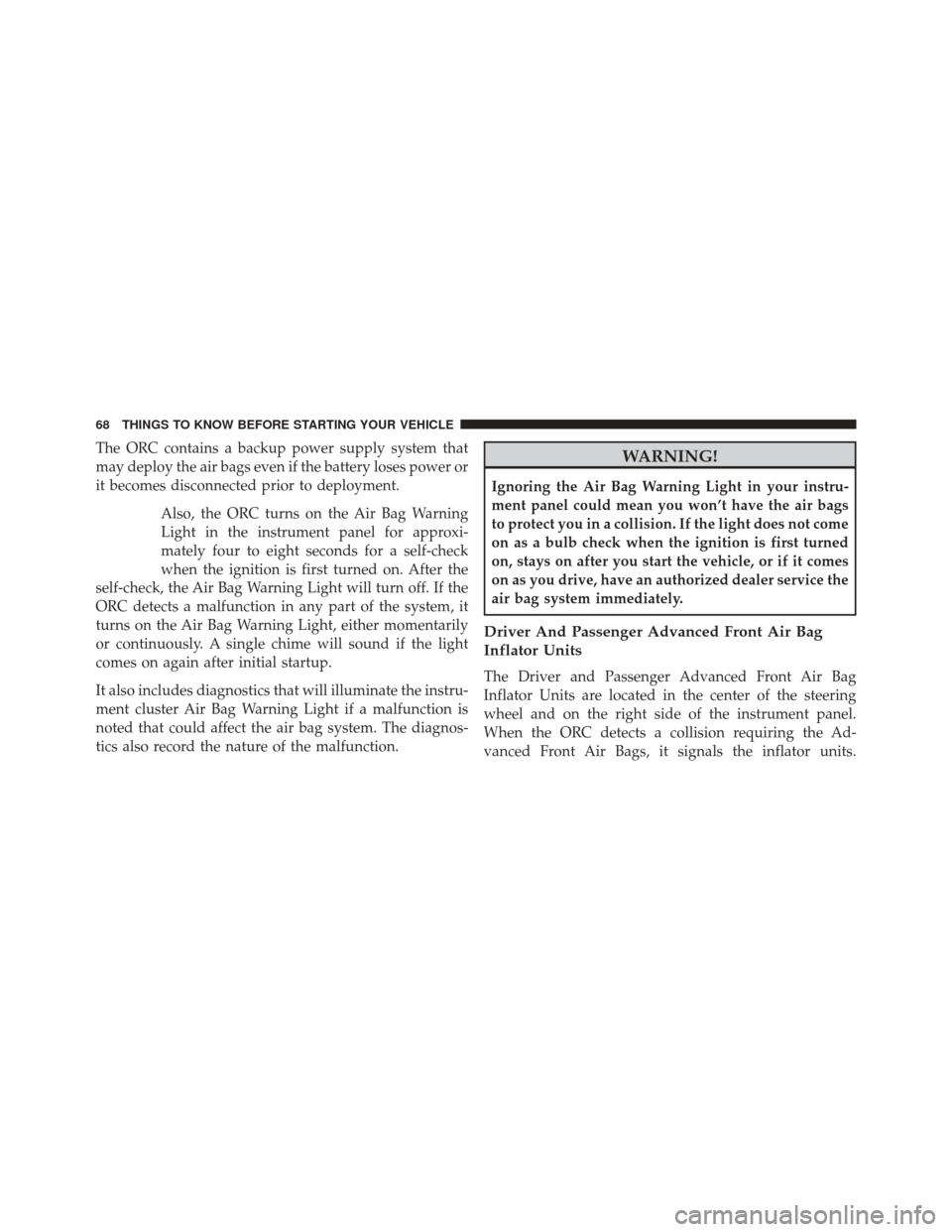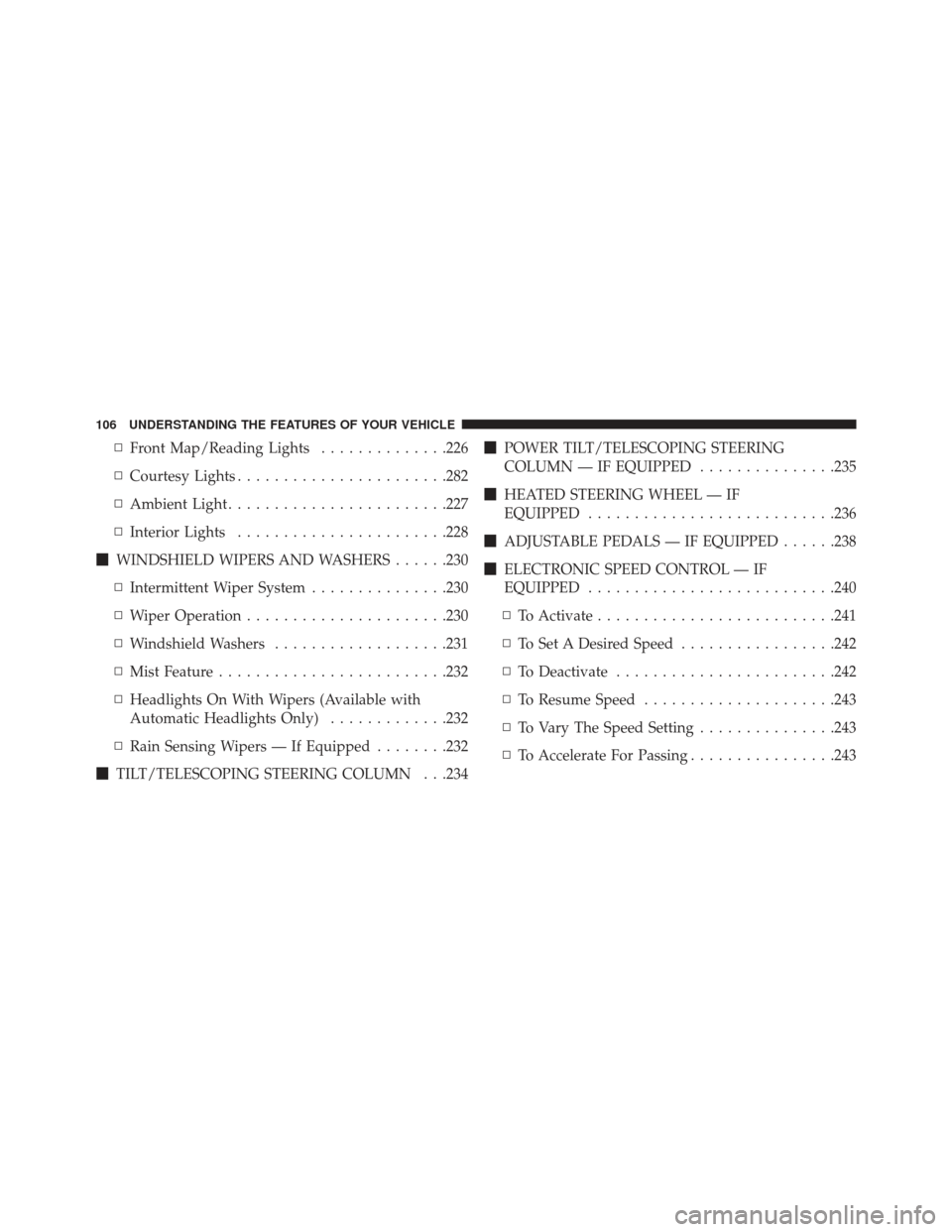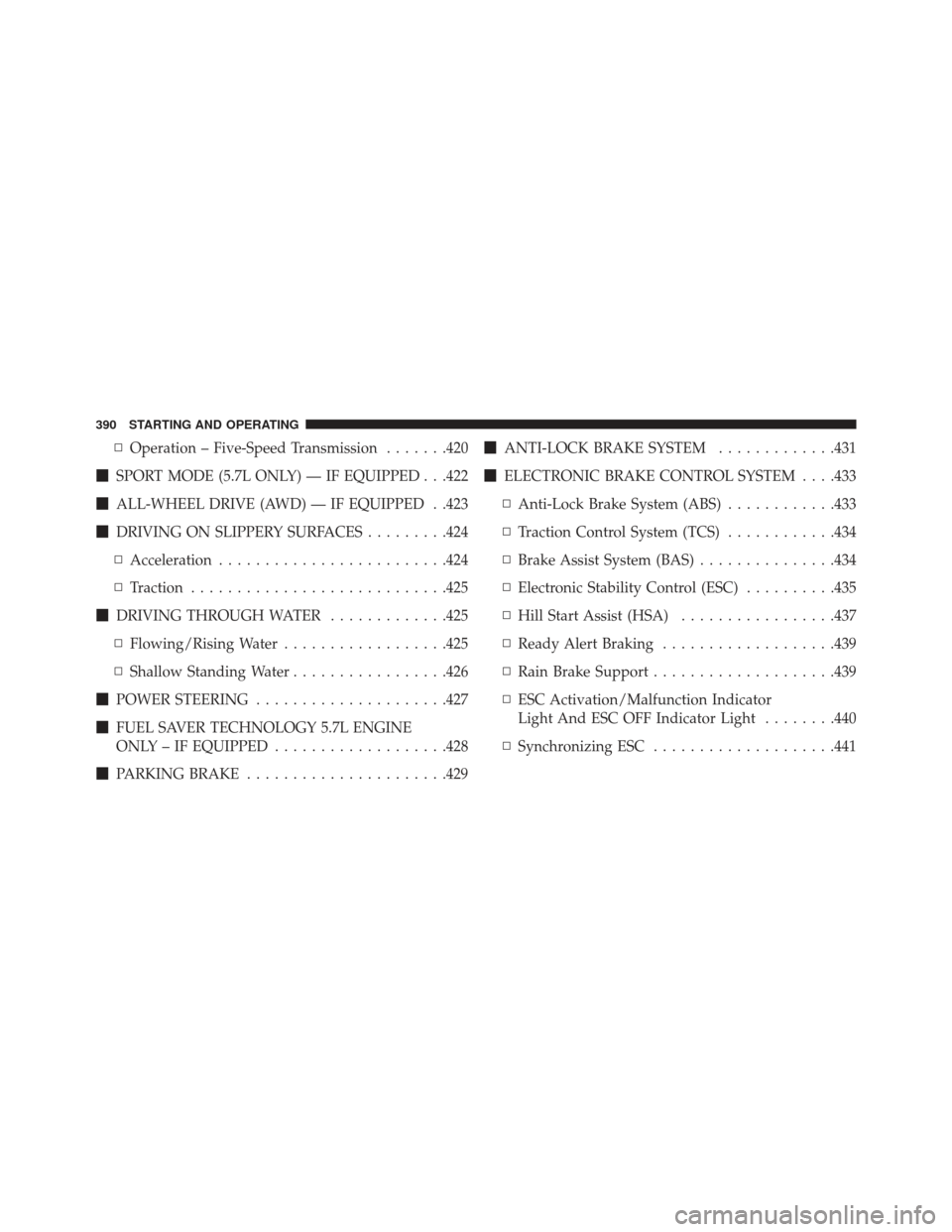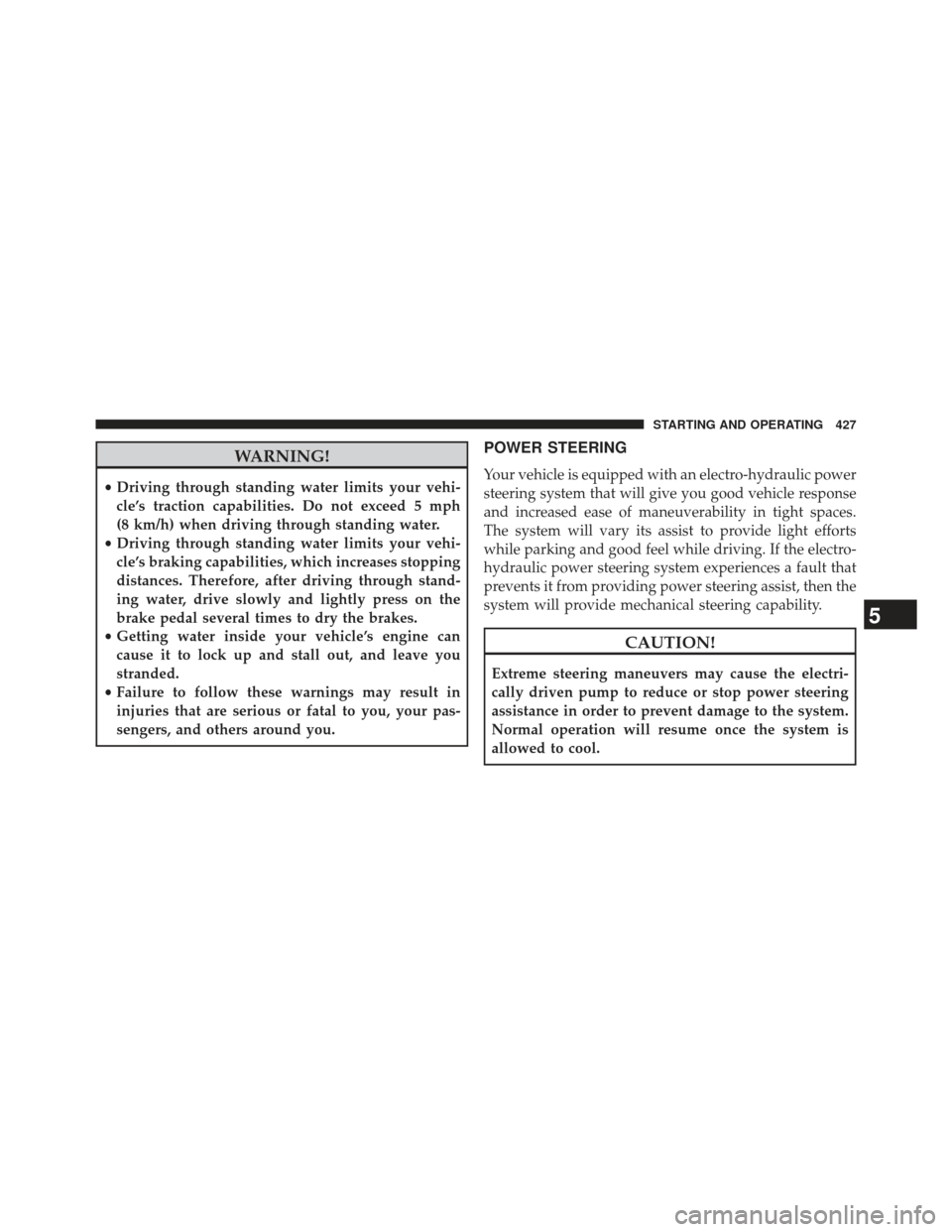Page 70 of 631

The ORC contains a backup power supply system that
may deploy the air bags even if the battery loses power or
it becomes disconnected prior to deployment.Also, the ORC turns on the Air Bag Warning
Light in the instrument panel for approxi-
mately four to eight seconds for a self-check
when the ignition is first turned on. After the
self-check, the Air Bag Warning Light will turn off. If the
ORC detects a malfunction in any part of the system, it
turns on the Air Bag Warning Light, either momentarily
or continuously. A single chime will sound if the light
comes on again after initial startup.
It also includes diagnostics that will illuminate the instru-
ment cluster Air Bag Warning Light if a malfunction is
noted that could affect the air bag system. The diagnos-
tics also record the nature of the malfunction.WARNING!
Ignoring the Air Bag Warning Light in your instru-
ment panel could mean you won’t have the air bags
to protect you in a collision. If the light does not come
on as a bulb check when the ignition is first turned
on, stays on after you start the vehicle, or if it comes
on as you drive, have an authorized dealer service the
air bag system immediately.
Driver And Passenger Advanced Front Air Bag
Inflator Units
The Driver and Passenger Advanced Front Air Bag
Inflator Units are located in the center of the steering
wheel and on the right side of the instrument panel.
When the ORC detects a collision requiring the Ad-
vanced Front Air Bags, it signals the inflator units.
68 THINGS TO KNOW BEFORE STARTING YOUR VEHICLE
Page 104 of 631
Periodic Safety Checks You Should Make Outside
The Vehicle
Tires
Examine tires for excessive tread wear and uneven wear
patterns. Check for stones, nails, glass, or other objects
lodged in the tread or sidewall. Inspect the tread for cuts
and cracks. Inspect sidewalls for cuts, cracks and bulges.
Check the wheel nuts for tightness. Check the tires
(including spare) for proper cold inflation pressure.
Lights
Have someone observe the operation of brake lights and
exterior lights while you work the controls. Check turn
signal and high beam indicator lights on the instrument
panel.
Door Latches
Check for positive closing, latching, and locking.
Fluid Leaks
Check area under vehicle after overnight parking for fuel,
engine coolant, oil, or other fluid leaks. Also, if gasoline
fumes are detected or if fuel, power steering fluid, or
brake fluid leaks are suspected, the cause should be
located and corrected immediately.
102 THINGS TO KNOW BEFORE STARTING YOUR VEHICLE
Page 108 of 631

▫Front Map/Reading Lights ..............226
▫ Courtesy Lights ...................... .282
▫ Ambient Light ....................... .227
▫ Interior Lights ...................... .228
� WINDSHIELD WIPERS AND WASHERS ......230
▫ Intermittent Wiper System ...............230
▫ Wiper Operation ..................... .230
▫ Windshield Washers ...................231
▫ Mist Feature ........................ .232
▫ Headlights On With Wipers (Available with
Automatic Headlights Only) .............232
▫ Rain Sensing Wipers — If Equipped ........232
� TILT/TELESCOPING STEERING COLUMN . . .234 �
POWER TILT/TELESCOPING STEERING
COLUMN — IF EQUIPPED ...............235
� HEATED STEERING WHEEL — IF
EQUIPPED .......................... .236
� ADJUSTABLE PEDALS — IF EQUIPPED ......238
� ELECTRONIC SPEED CONTROL — IF
EQUIPPED .......................... .240
▫ To Activate ......................... .241
▫ To Set A Desired Speed .................242
▫ To Deactivate ....................... .242
▫ To Resume Speed .....................243
▫ To Vary The Speed Setting ...............243
▫ To Accelerate For Passing ................243
106 UNDERSTANDING THE FEATURES OF YOUR VEHICLE
Page 216 of 631

The memory seat switch is located on the driver ’s door
trim panel. The switch consists of three buttons: The (S)
button, which is used to activate the memory save
function and the (1) and (2) buttons which are used to
recall either of two pre-programmed memory profiles.Programming The Memory Feature
NOTE:Saving a new memory profile will erase an
existing profile from memory.
To create a new memory profile, perform the following:
1. Place the ignition into the RUN position.
2. Adjust all memory profile settings to desired prefer- ences (i.e., seat, side mirror, adjustable pedals [if
equipped], power tilt and telescopic steering column
[if equipped], and radio station presets).
3. Press and release the SET (S) button on the memory switch.
4.
Within five seconds, press and release the MEMORY
button 1 or 2. The Electronic Vehicle Information Center
(EVIC) (if equipped) will display which memory posi-
tion has been set.
Memory Seat Switches
214 UNDERSTANDING THE FEATURES OF YOUR VEHICLE
Page 218 of 631

Memory Position Recall
NOTE:The vehicle must be in PARK to recall memory
positions. If a recall is attempted when the vehicle is not in
PARK, a message will display in the EVIC (if equipped).
To recall the memory settings for driver 1, press
MEMORY button number 1 on the driver’s door or the
UNLOCK button on the RKE transmitter linked to
memory position 1.
To recall the memory setting for driver 2, press MEMORY
button number 2 on the driver’s door or the UNLOCK
button on the RKE transmitter linked to memory position 2.
A recall can be cancelled by pressing any of the
MEMORY buttons (S, 1, or 2) on the driver’s door during
a recall. When a recall is cancelled, the driver’s seat, side
mirror, adjustable pedals (if equipped), and power tilt
and telescopic steering column (if equipped) stop mov-
ing. A delay of one second will occur before another recall
can be selected.
Easy Entry/Exit Seat (Available With Memory
Seat Only)
This feature provides automatic driver seat positioning to
enhance driver mobility when entering and exiting the
vehicle.
The distance the driver’s seat moves depends on where
you have the driver’s seat positioned when you remove
the Key Fob from the ignition (or change the ignition to
OFF, for vehicles equipped with Keyless Enter-N-Go).
• When you remove the Key Fob from the ignition (or
change the ignition to OFF, for vehicles equipped with
Keyless Enter-N-Go), the driver’s seat will move about
2.4 in (60 mm) rearward if the driver’s seat position is
greater than or equal to 2.7 in (67.7 mm) forward of the
rear stop. The seat will return to its previously set
position when you place the ignition into the ACC or
RUN position.
216 UNDERSTANDING THE FEATURES OF YOUR VEHICLE
Page 237 of 631
POWER TILT/TELESCOPING STEERING
COLUMN — IF EQUIPPED
This feature allows you to tilt the steering column
upward or downward. It also allows you to lengthen or
shorten the steering column. The power tilt/telescoping
steering column lever is located below the multifunction
lever on the steering column.To tilt the steering column, move the lever up or down as
desired. To lengthen or shorten the steering column, pull
the lever toward you or push the lever away from you as
desired.
Power Tilt/Telescoping Switch
3
UNDERSTANDING THE FEATURES OF YOUR VEHICLE 235
Page 392 of 631

▫Operation – Five-Speed Transmission .......420
� SPORT MODE (5.7L ONLY) — IF EQUIPPED . . .422
� ALL-WHEEL DRIVE (AWD) — IF EQUIPPED . .423
� DRIVING ON SLIPPERY SURFACES .........424
▫ Acceleration ........................ .424
▫ Traction ........................... .425
� DRIVING THROUGH WATER .............425
▫ Flowing/Rising Water ..................425
▫ Shallow Standing Water .................426
� POWER STEERING .....................427
� FUEL SAVER TECHNOLOGY 5.7L ENGINE
ONLY – IF EQUIPPED ...................428
� PARKING BRAKE ..................... .429�
ANTI-LOCK BRAKE SYSTEM .............431
� ELECTRONIC BRAKE CONTROL SYSTEM . . . .433
▫ Anti-Lock Brake System (ABS) ............433
▫ Traction Control System (TCS) ............434
▫ Brake Assist System (BAS) ...............434
▫ Electronic Stability Control (ESC) ..........435
▫ Hill Start Assist (HSA) .................437
▫ Ready Alert Braking ...................439
▫ Rain Brake Support ....................439
▫ ESC Activation/Malfunction Indicator
Light And ESC OFF Indicator Light ........440
▫ Synchronizing ESC ....................441
390 STARTING AND OPERATING
Page 429 of 631

WARNING!
•Driving through standing water limits your vehi-
cle’s traction capabilities. Do not exceed 5 mph
(8 km/h) when driving through standing water.
• Driving through standing water limits your vehi-
cle’s braking capabilities, which increases stopping
distances. Therefore, after driving through stand-
ing water, drive slowly and lightly press on the
brake pedal several times to dry the brakes.
• Getting water inside your vehicle’s engine can
cause it to lock up and stall out, and leave you
stranded.
• Failure to follow these warnings may result in
injuries that are serious or fatal to you, your pas-
sengers, and others around you.
POWER STEERING
Your vehicle is equipped with an electro-hydraulic power
steering system that will give you good vehicle response
and increased ease of maneuverability in tight spaces.
The system will vary its assist to provide light efforts
while parking and good feel while driving. If the electro-
hydraulic power steering system experiences a fault that
prevents it from providing power steering assist, then the
system will provide mechanical steering capability.
CAUTION!
Extreme steering maneuvers may cause the electri-
cally driven pump to reduce or stop power steering
assistance in order to prevent damage to the system.
Normal operation will resume once the system is
allowed to cool.
5
STARTING AND OPERATING 427